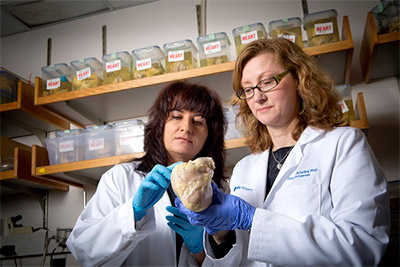New UNC-Duke Collaboration Applies Cystic Fibrosis Therapies to Heart Disease
Given sufficient time, many forms of cardiovascular disease turn into heart failure, our nation’s number one killer. The disease affects six million Americans and costs the health care system a whopping $39 billion a year. Despite intense efforts to discover new heart medications, none of the current therapies have been able to halt its relentless progression.

As a result, researchers have begun looking to other diseases for inspiration. Cystic fibrosis, for instance, is experiencing a golden age of drug development. Several new drugs are in the pipeline to correct specific disease-causing defects in the cystic fibrosis transmembrane regulator (CFTR), a protein needed to keep airways hydrated. These advances are so noteworthy that President Obama even mentioned them in his recent State of the Union address, saying “in some patients with cystic fibrosis, this approach has reversed a disease once thought unstoppable.”
These drugs have the potential to alleviate conditions other than cystic fibrosis because their target is present not only in the lungs, but also other tissues and organs. Recently, Duke cardiovascular researcher Dawn Bowles, PhD, and UNC cystic fibrosis expert Martina Gentzsch, PhD, received a $50,000 grant to explore the feasibility of repurposing CFTR drugs for the treatment of cardiovascular disease. The award is part of an effort by the neighboring CTSAs to combine resources and expertise to tackle problems that impact human health.
As director of the CFTR Correction Core within the Marsico Lung Institute at UNC, Gentzsch has spent years studying how defects in the CFTR protein can cause the lungs to clog up with thick, sticky mucus that is prone to infection. CFTR is an ion channel, a type of molecular expressway that allows tiny chloride ions to move across the surface of the lungs. Mutations in the CFTR gene either block the chloride highway or lock it deep inside the cells, resulting in an imbalance of salt and water that dehydrates the airways. Understanding the mechanisms of this dysfunction has enabled the development of new therapies that specifically target these genetic defects to either open up the channel or push it to the surface.
“CFTR is so well studied in the airways that we can start thinking about how defects in the protein might affect other organs, such as the heart,” said Gentzsch, an assistant professor at the UNC School of Medicine. “There is suspicion that the protein normally plays a protective role in the heart, but more evidence is required.”So when Bowles asked to borrow some antibodies, specific reagents that can be used to measure the levels of the CFTR protein in heart tissues, she gladly handed them over. Bowles co-directs the Duke Human Heart Repository, one of the largest heart repositories in the United States and home to 500 hearts and 40,000 specimens of heart tissue. Using the antibodies from UNC, she found that the CFTR protein was significantly diminished in tissues from heart failure patients as compared to healthy individuals.
“Essentially, we discovered that this protein is somehow disrupted in failing hearts,” said Bowles, an assistant professor at the Duke School of Medicine. “Now the question is can we reverse that defect, and is it even important in the disease process? We want to determine whether we modulate it with existing CFTR drugs, or if we have to design different drugs to target different aspects of the protein.”
The CFTR protein might behave completely different in the heart than in the lungs. Bowles and Gentzsch will use the grant to perform a number of molecular studies to investigate whether specific changes in the CFTR gene and protein are associated with cardiovascular disease and heart failure. The researchers will also conduct a number of biochemical and electrophysiological experiments on human heart cells and tissues to determine how the CFTR channel functions in the framework of the cardiovascular system, particularly after treatment with CFTR therapies.
“I think that our research will give us a better understanding of the biology of this molecule in the context of the human heart,” said Bowles. “We hope to collect the preliminary data needed to study the role of CFTR in heart disease in pre-clinical models. Ultimately, the therapies that stem from this and similar efforts could make a significant impact in the treatment of cardiovascular disease and heart failure.”
The new team of Bowles and Gentzsch are one of four to recently receive collaborative grants from the North Carolina Translational and Clinical Sciences (NC TraCS) Institute and the Duke University Translational Medicine Institute (DTMI). The awards place particular emphasis on basic research in a variety of disciplines that address the development of therapies, diagnostics or devices applicable to human disease and clinical trials.
UNC and Duke are the only two academic institutions in North Carolina that are members of the CTSA program, a national consortium created to improve the way biomedical research is conducted across the country. The CTSA program is funded by the National Center for Advancing Translational Sciences (NCATS), a part of the National Institutes of Health (NIH).
- Created on .